So, with a lot of time to search the local area what did I end up with?
I'm not going to post too many shots of the likes of species I have seen before, after all I recorded something in the region of 100 species on camera. Instead I'll share the special ones.
Early in the first week I was out early and met a bird guide and his client who were happy to share their sighting, a Striped Kingfisher,
 I later found out that there were supposedly 2 in the area so I looked several times and found one of them anyway.This was a Kotu first for me and I was able to get my best shots of the species ever.
I later found out that there were supposedly 2 in the area so I looked several times and found one of them anyway.This was a Kotu first for me and I was able to get my best shots of the species ever.
 Another Kotu first, and a special bird was a Little Bittern.
Another Kotu first, and a special bird was a Little Bittern.
 It was pretty furtive, refusing to come out to the edge of the mangroves.
It was pretty furtive, refusing to come out to the edge of the mangroves.
 It was only the third time I have ever seen one so very pleasing to see it at all, especially as it disappeared altogether the last week I was there.
While I was sat waiting for the Little Bittern to appear a Grey Woodpecker paid a visit to a dead tree stump.
It was only the third time I have ever seen one so very pleasing to see it at all, especially as it disappeared altogether the last week I was there.
While I was sat waiting for the Little Bittern to appear a Grey Woodpecker paid a visit to a dead tree stump.
 giving some excellent views but it was one seen quite often in several spots.
giving some excellent views but it was one seen quite often in several spots.
 The Fine -spotted Woodpecker pair were even more obliging on one morning walk.
The Fine -spotted Woodpecker pair were even more obliging on one morning walk.
 I had them both on the same stalk
I had them both on the same stalk
 Another bird that gave me possibly my best ever shots was a Giant Kingfisher that I found sat on an old bridge support.
Another bird that gave me possibly my best ever shots was a Giant Kingfisher that I found sat on an old bridge support.
 but one I didn't bother with at all really was the Pied Kingfisher
but one I didn't bother with at all really was the Pied Kingfisher
 I, like most who visit had overdosed on the species in the past so ignored them until the last day when I added to the 4 shots I already had, one of a bird with fish. You can't really go home without one can you? It's such an easy shot to get in TG though, unlike the Kingfishers we have in the U.K. where you are lucky to get a shot at all.
I, like most who visit had overdosed on the species in the past so ignored them until the last day when I added to the 4 shots I already had, one of a bird with fish. You can't really go home without one can you? It's such an easy shot to get in TG though, unlike the Kingfishers we have in the U.K. where you are lucky to get a shot at all.
 Note the African Spoonbill legs in the background!!
Getting decent shots of Sunbirds isn't easy, well maybe the Beautiful Sunbird isn't too bad.
Note the African Spoonbill legs in the background!!
Getting decent shots of Sunbirds isn't easy, well maybe the Beautiful Sunbird isn't too bad.
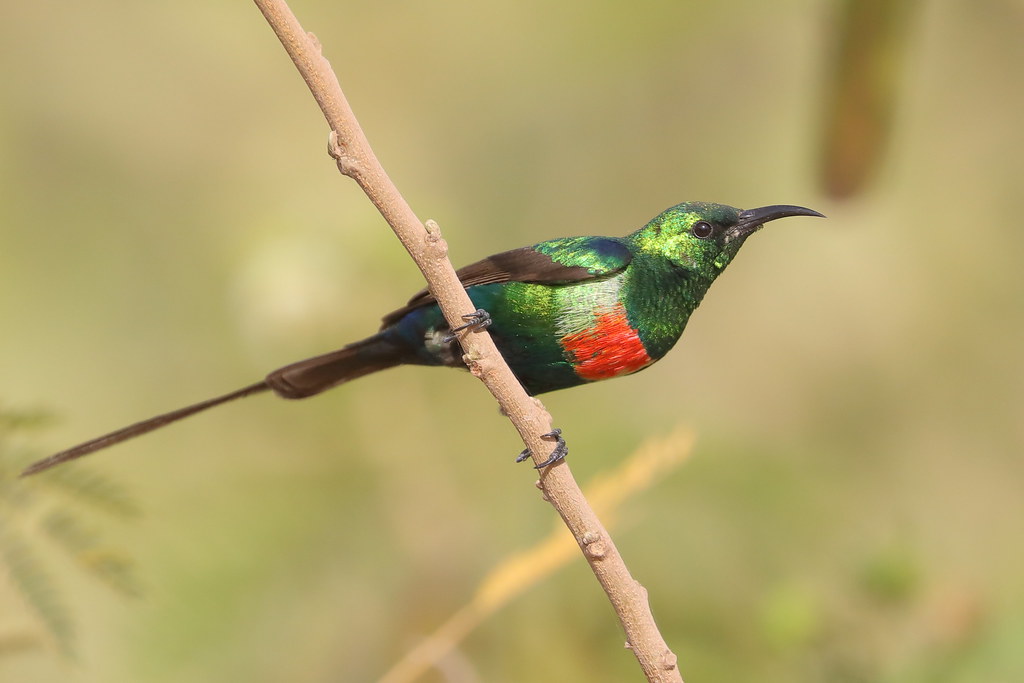 but I was really annoyed with myself for messing up an opportunity with this Splendid Sunbird. Probably the best I have ever managed but could have been soo much better. Sat still, OK, I'm hand holding a 500mm and the bird is in deep, deep shade but did I really need a shutter speed of 1/2000th? No! It pushed the ISO up to 10,000.
but I was really annoyed with myself for messing up an opportunity with this Splendid Sunbird. Probably the best I have ever managed but could have been soo much better. Sat still, OK, I'm hand holding a 500mm and the bird is in deep, deep shade but did I really need a shutter speed of 1/2000th? No! It pushed the ISO up to 10,000.
 I was too busy checking the exposure to notice what settings I had. Never mind.
One of my best finds though were some Grey-backed Camaroptera that were holding territory in a distant corner that I have never ventured to before. They are easy to hear but hard to photograph as they move around in the scrubby bushes. It took me two mornings work to get these
I was too busy checking the exposure to notice what settings I had. Never mind.
One of my best finds though were some Grey-backed Camaroptera that were holding territory in a distant corner that I have never ventured to before. They are easy to hear but hard to photograph as they move around in the scrubby bushes. It took me two mornings work to get these
 but I was a happy tog as a result.
but I was a happy tog as a result.
 There is one bird that I never tire of seeing and photographing and on this trip I think I did better than ever.
There is one bird that I never tire of seeing and photographing and on this trip I think I did better than ever.
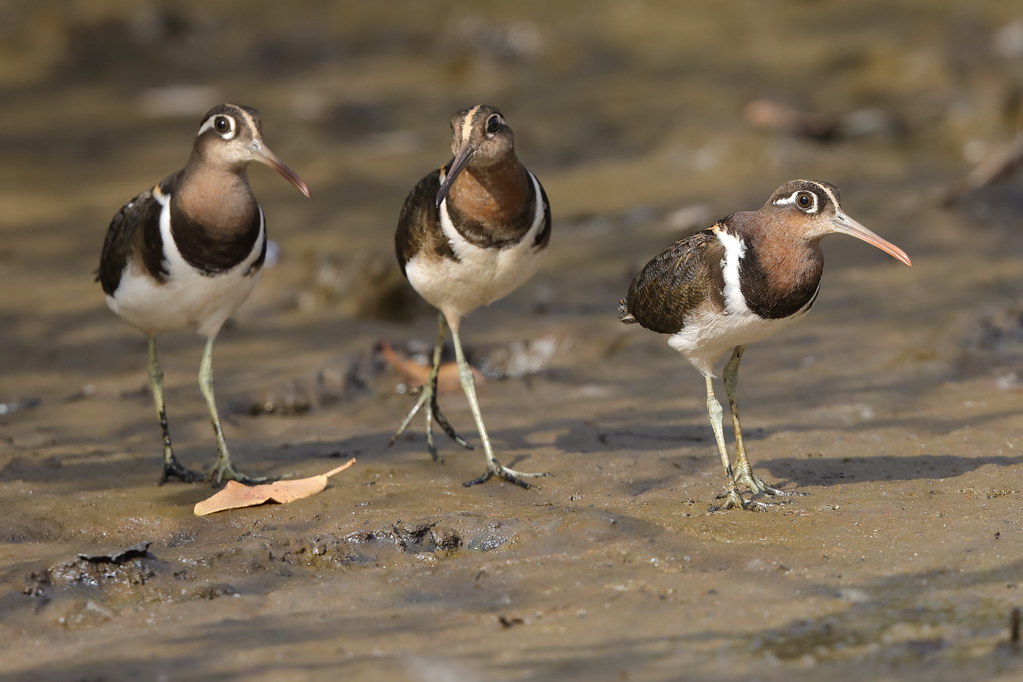 They are stunning little birds but are very shy too.
They are stunning little birds but are very shy too.
 The local bird guides put a lot of time and effort in to building a special hide to view them and so it's with a sense of bemusement, disappointment, bewilderment...you name it... but they have allowed it to fall in to total disrepair.
They even laid a 50m or so footpath made of old car tyres filled with what is now compacted mud that's as hard as concrete that allows a passage through the black slimy mud .
So much hard work and yet it has all been wasted, well not quite. The footpath was a great aid still and although the hide doesn't offer much camouflage it's still a great spot to see the Snipe. I went three times in all, two were pretty much no shows, in fact the first visit drew a total blank but I glad I tried again because the second visit was the most spectacular I have had.
The local bird guides put a lot of time and effort in to building a special hide to view them and so it's with a sense of bemusement, disappointment, bewilderment...you name it... but they have allowed it to fall in to total disrepair.
They even laid a 50m or so footpath made of old car tyres filled with what is now compacted mud that's as hard as concrete that allows a passage through the black slimy mud .
So much hard work and yet it has all been wasted, well not quite. The footpath was a great aid still and although the hide doesn't offer much camouflage it's still a great spot to see the Snipe. I went three times in all, two were pretty much no shows, in fact the first visit drew a total blank but I glad I tried again because the second visit was the most spectacular I have had.
 So in finishing this report all I can say is if you have never been I don't think you'll be disappointed. There are now hotels to cover most tastes and budgets but think carefully when you choose. The tourist season runs from November through to April and when ever you go there will be plenty about. Will I return? I guess it's inevitable! When I'm looking for some winter sun and a cheap break it's the first port of call however, maybe it's time to explore a new base.We'll see.
Thanks for reading along, hope the information is of use.
Dave
So in finishing this report all I can say is if you have never been I don't think you'll be disappointed. There are now hotels to cover most tastes and budgets but think carefully when you choose. The tourist season runs from November through to April and when ever you go there will be plenty about. Will I return? I guess it's inevitable! When I'm looking for some winter sun and a cheap break it's the first port of call however, maybe it's time to explore a new base.We'll see.
Thanks for reading along, hope the information is of use.
Dave
So, my mind was made up, well almost, not to bother taking any more trips, I'd concentrate on what was about locally and that of course changes not only from year to year and time of year but from day to day. Birds are territorial so the more you are familiar with an area the more chance of seeing what lives there and no matter where you visit, never judge it on first appearances.
For me a typical day started around 7.15 to 7.30am. That's first light really, well, when the light is acceptable for photography anyway.
 As I am not fond of getting up earlier than needed it suited me fine.The Bakotu Hotel backs on to the mudflats of the creek and the golf course and a handy back gate takes you there.
At 7.30 am it's hardly likely that there is anyone playing golf so no need to worry about stray balls either, a bit different on the way back.
Head up to the nearest green, they are actually black and made of compacted sand, and at this time of day you might be surprised at what you see.
Not an eagle but a birdie shot! This Yellow-billed Kite had a plan!
As I am not fond of getting up earlier than needed it suited me fine.The Bakotu Hotel backs on to the mudflats of the creek and the golf course and a handy back gate takes you there.
At 7.30 am it's hardly likely that there is anyone playing golf so no need to worry about stray balls either, a bit different on the way back.
Head up to the nearest green, they are actually black and made of compacted sand, and at this time of day you might be surprised at what you see.
Not an eagle but a birdie shot! This Yellow-billed Kite had a plan!
 I think it took a fancy to the flag for nesting material.
I think it took a fancy to the flag for nesting material.
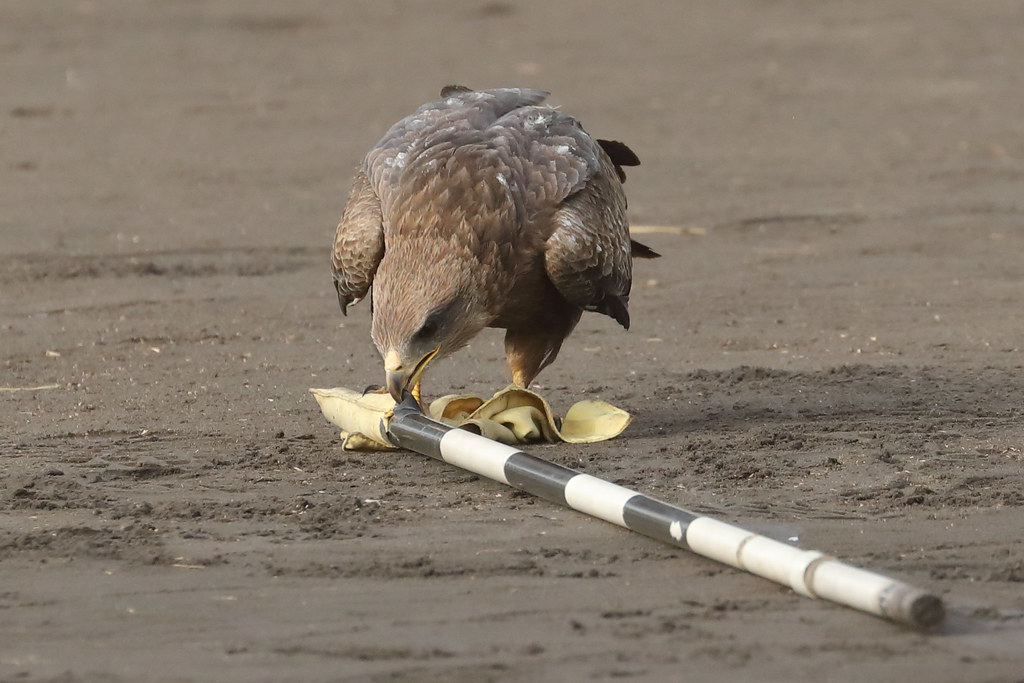 but the best efforts to tear it off the pole failed.
but the best efforts to tear it off the pole failed.
 It attempted to fly off with the whole thing but despite getting it off the ground failed to get airborne. I was really annoyed I'd put the camera down!
Carry on across the golf course and you drop on to a bridge that takes you across the creek, and on to one of the golf tees.
It attempted to fly off with the whole thing but despite getting it off the ground failed to get airborne. I was really annoyed I'd put the camera down!
Carry on across the golf course and you drop on to a bridge that takes you across the creek, and on to one of the golf tees.
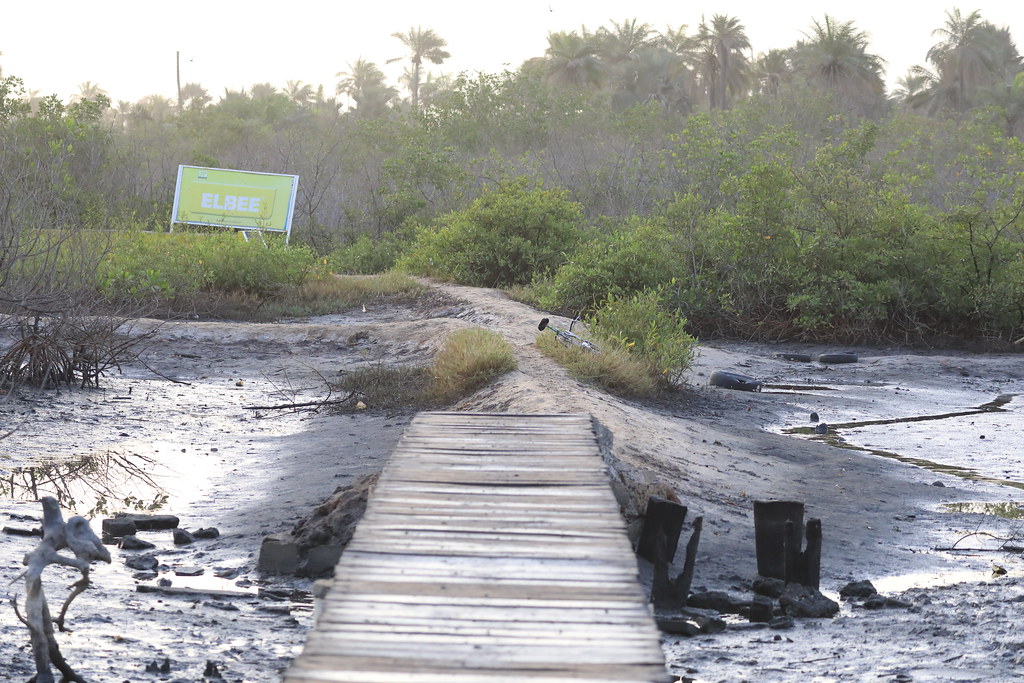 It's one of the places you can use to avoid going in to the mud in an attempt to get a shot of something, in this case a couple of guys fishing.
It's one of the places you can use to avoid going in to the mud in an attempt to get a shot of something, in this case a couple of guys fishing.
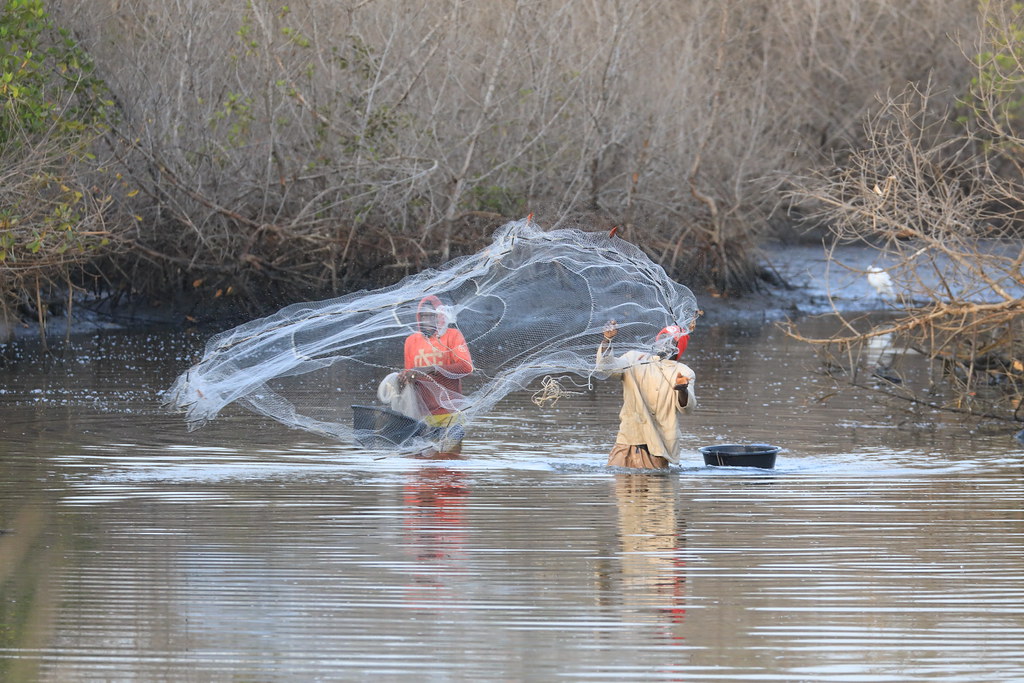 The local bird guide association claim that the creek is much better as a result of the fact they now control it and have stopped fishing. Not so, these guys get up early, and who can blame them. Earning a crust isn't easy and they were catching fish by the big bucket load and enough to feed lots of hungry mouths too. What amazed me is they enter the water fully clothed , trainers as well. Must be awful walking home like that.
Anyway, looking back you can now see the golf course.
The local bird guide association claim that the creek is much better as a result of the fact they now control it and have stopped fishing. Not so, these guys get up early, and who can blame them. Earning a crust isn't easy and they were catching fish by the big bucket load and enough to feed lots of hungry mouths too. What amazed me is they enter the water fully clothed , trainers as well. Must be awful walking home like that.
Anyway, looking back you can now see the golf course.
 but carry on, a swift right turn and you find your way towards the sewerage ponds, the rice paddies and everything else that signed as the "Nature Trail" if you enter from Kotu Bridge.
Much depended on what I saw and where as to how far I went.
On the very first morning I was delighted to stumble across a Double-spurred Francolin wandering across the path right in front of me. I fired off some shots and was delighted as I have struggled to get a decent view and image in the past however, in the course of the week I got even better ones as the light was better!
but carry on, a swift right turn and you find your way towards the sewerage ponds, the rice paddies and everything else that signed as the "Nature Trail" if you enter from Kotu Bridge.
Much depended on what I saw and where as to how far I went.
On the very first morning I was delighted to stumble across a Double-spurred Francolin wandering across the path right in front of me. I fired off some shots and was delighted as I have struggled to get a decent view and image in the past however, in the course of the week I got even better ones as the light was better!
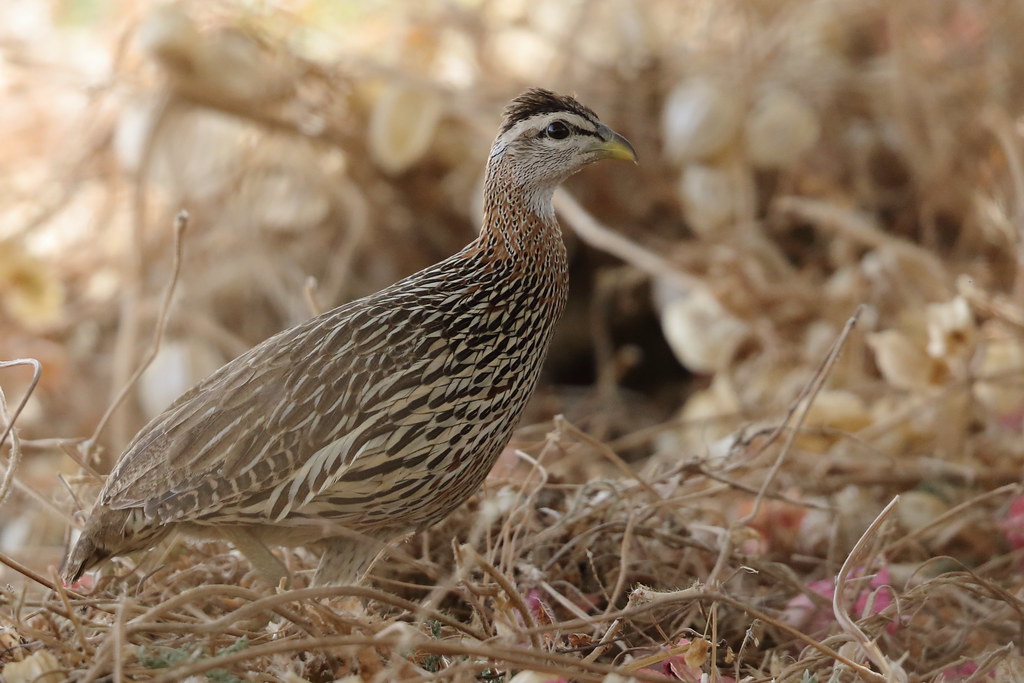 They included the standard view...one that's running away!
They included the standard view...one that's running away!
 Shows off the spurs well when in retreat!
Every day was different though, some days better than others.
Typically though an early walk was followed by a later breakfast with Claire at around 9.30 when the usual earlier rush had died down. It was then a decision as whether to go back out, check out what I'd taken on the laptop or a combination of both.
TBC
Shows off the spurs well when in retreat!
Every day was different though, some days better than others.
Typically though an early walk was followed by a later breakfast with Claire at around 9.30 when the usual earlier rush had died down. It was then a decision as whether to go back out, check out what I'd taken on the laptop or a combination of both.
TBC
Well, from the last post you might well wonder what the next trip might be and how dissatisfied could I be with that!
I have to admit, we photographers are never happy, We always want to improve on a previous best image of a particular species. That's why we often try time and time again for then same species that are common at home. I have always maintained though that an interesting shot of a common species is better than a shot of a rare bird sat on a branch. The same can be said when on holiday too although it's always nice to add new species to your portfolio, home or abroad.
As with all wildlife photography there can be no guarantees that you will see anything, never mind get a photograph. Hides and guides will help though and if you are abroad your time is limited so short cuts are welcome and a guide will certainly stand you a much better chance of seeing more species.
In The Gambia though the concept of a bird hide is one that as yet has barely been tried. The trade in photography tourism is on the rise across the whole globe as what was once unaffordable equipment is now available to amateur hands like myself.
On this particular trip I took Canon 1DX11 and 5D1V bodies, a 100-400mm zoom and 500mm f4 prime lens along with teleconverters and an expensive tripod and head. Added together you could buy a family car for the cost of purchasing them brand new! My choice of how to spend my life savings!! You could however come close to the same fire power for much much less.
For my second trip I teamed up with another person I already knew , again someone I'd met at the Bakotu hotel a couple of years previously but kept in touch with. He'd already been on an "up river" trip and had a day at a specific location that when he described it I was keen to try. Off we went with a different guide and one I have used in the past for an agreed price of £50 for the half day tour. An hour or so's drive found us about 100m beyond the spot I'd been to a couple of days previously to view the Owls. Maybe guide Number 1 hasn't a clue this place even exists?
From a guiding point of view , there wasn't much need although the expert eyes were very helpful. These local guides seem to have much better eyesight than we do, maybe genetics I don't know but I am often amazed at what they pick out that I haven't seen.
The place itself was interesting and a definite step in the right direction from a photographic point of view but it was far from the finished article. A large garden with several more pots of water as well as a much bigger water hole which may well have been an irrigation aid for the garden . Whatever, it did attract birds to both, the light was much better but we were still some distance from our subjects. A simple screen would hide our presence to enable much closer views.
Nevertheless I got to take photographs of some more species seen just the once during the holiday.
 African Pygmy Kingfisher was a superb find and one only seen twice in the past.
African Pygmy Kingfisher was a superb find and one only seen twice in the past.
 Melodious Warbler gave me my best shots ever as did the Greater Honeyguide.
Melodious Warbler gave me my best shots ever as did the Greater Honeyguide.
 Although in truth I saw that two days before as well on my other guided trip.
The same could almost be said of the Lesser Honeyguide. I saw one locally to the hotel but it was extremely brief and my photo was a write off.
Although in truth I saw that two days before as well on my other guided trip.
The same could almost be said of the Lesser Honeyguide. I saw one locally to the hotel but it was extremely brief and my photo was a write off.
 The other Honeyguide was indeed a "lifer" and again not seen elsewhere.
The other Honeyguide was indeed a "lifer" and again not seen elsewhere.
 That's the Spotted Honeyguide which didn't offer the best of photo opportunities, again, distance being a major problem too.
To make up the collection of bird species seen here and nowhere else I could add.
Snowy-crowned Robin-chat
That's the Spotted Honeyguide which didn't offer the best of photo opportunities, again, distance being a major problem too.
To make up the collection of bird species seen here and nowhere else I could add.
Snowy-crowned Robin-chat
 Lavendar Waxbill
Lavendar Waxbill
 and Black-rumped Waxbill
and Black-rumped Waxbill
 and if I'm honest I suppose I could have tried for better photos had I not been distracted by more attractive ( to me) species as I have photographed them in similar circumstances in the past.
To make up the days sightings I had Red-cheeked Cordon Bleu, one I usually see in Kotu but not this time.
and if I'm honest I suppose I could have tried for better photos had I not been distracted by more attractive ( to me) species as I have photographed them in similar circumstances in the past.
To make up the days sightings I had Red-cheeked Cordon Bleu, one I usually see in Kotu but not this time.
 and another pair of Cardinal Woodpeckers but with less photographic opportunity than the previous trip.So there again though, a guided trip had paid off . Between the two half days I had added 25 species I wouldn't see at Kotu.
A combined price of £60. Not bad but for reasons I can't really explain I decided not to bother with any more trips and stay local. It wasn't just the money side, it was about having breakfast with my wife instead of deserting her to eat alone when I set off at the crack of dawn. It was about the expectation of not seeing much I hadn't seen already and yet these two previous trips had indeed served up several "lifers". I think part of it was about keeping something for next time because as always, I know I will return.
TBC
and another pair of Cardinal Woodpeckers but with less photographic opportunity than the previous trip.So there again though, a guided trip had paid off . Between the two half days I had added 25 species I wouldn't see at Kotu.
A combined price of £60. Not bad but for reasons I can't really explain I decided not to bother with any more trips and stay local. It wasn't just the money side, it was about having breakfast with my wife instead of deserting her to eat alone when I set off at the crack of dawn. It was about the expectation of not seeing much I hadn't seen already and yet these two previous trips had indeed served up several "lifers". I think part of it was about keeping something for next time because as always, I know I will return.
TBC
In the last post I tried to point out some of the options you have when deciding on a trip to The Gambia, now I'll share mine!
As a frugal pensioner who wants to spread my travel pound as far as I can comfortably push it my usual port of call for The Gambia is a package tour as the country is small, most places are in easy reach and I can find an attractive price for the basic holiday. What I then add on to that is at my own, I'll rephrase that there are two of us, our own discretion. Where and what to eat, where and how much to spend on drinks, whether or not to take any tours or trips.
This time I went with an open mind. I think I might have spent 2 weeks in Kotu in the past without ever venturing out on a trip, there again I have also paid a premium for a 10 day birding trip largely pre-organised, or even just a shorter one organised through a guiding contact I keep in touch with online. On my last visit I teamed up with a couple of guys I'd met in our hotel and took a couple of trips which, divided by three, worked out very reasonably priced.
As a rule of thumb, the guides try to get £100 for a full day trip that includes transport, £70 for a half day trip but supply and demand will indeed dictate what they get. Newcomers may well pay the whole fee and they are responsible for setting the bar fairly high in a country where the average wage is only a few pounds a month, never mind a day. Some would argue that a guide's season is limited, they have knowledge etc etc. Ok, whatever. Whichever way you look at it, a good guide gets paid extremely well but it also has to be pointed out that sometimes they have extended family to support too and I am happy to help inject some financial support in to the local economy.
This last occasion, as per usual I was approached by a guide who I haven't used before but know him from sight. Touting for business I said I would wait until I found someone to share the cost before deciding, but salesman as he was, he gave me another guest's name from our hotel who was in the same position. I sought out Laurence and together we agreed to take a trip with said guide at a price of £70 for the half day trip. As we were both in to photography as much as listing ticks we stressed that we wanted somewhere suitable for such.
Off we went and the first place we visited was a large dusty field on the edge of Farasutu woods in search of Black-headed Lapwing. I have been to similar places in the past, I had told this guide exactly what I expected and this was not the place I wanted to be. We were getting distant views and the Lapwings were constantly on the move to get away from us!
 A record shot but no more. The guide was hostile to my observation that this wasn't what I had asked for!
We continued walking, something else I had asked to avoid as I continue my recuperation from a recent spinal operation, especially as I was carrying a fair weight of camera and lens.
In one of the bushes we past we saw and managed photographs of a Black-crowned Tchagra
A record shot but no more. The guide was hostile to my observation that this wasn't what I had asked for!
We continued walking, something else I had asked to avoid as I continue my recuperation from a recent spinal operation, especially as I was carrying a fair weight of camera and lens.
In one of the bushes we past we saw and managed photographs of a Black-crowned Tchagra
 We spotted African Harrier -hawk flying
We spotted African Harrier -hawk flying
 and had a Woodchat Shrike on a farm building.
and had a Woodchat Shrike on a farm building.
 These were all the only ones I saw during the whole holiday which was also the case when we arrived at a fruiting fig tree that held numerous birds including Bruce's Green Pigeon.
These were all the only ones I saw during the whole holiday which was also the case when we arrived at a fruiting fig tree that held numerous birds including Bruce's Green Pigeon.
 and nearby another tree held a lifer for me, Pied Swallow.
and nearby another tree held a lifer for me, Pied Swallow.
 and down on the ground, yet another lifer, Singing Cisticola.
and down on the ground, yet another lifer, Singing Cisticola.
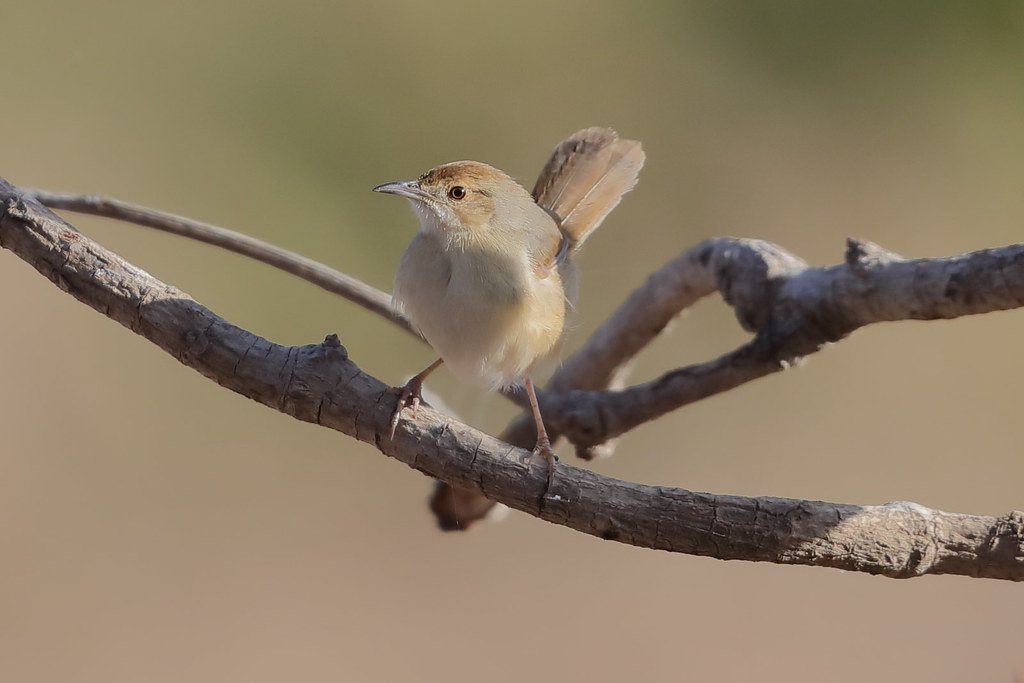 Those two I would have overlooked had it not been for the guide too.
Back in the fig tree, one of only two sightings of Cardinal Woodpecker ( the other on my next trip) and that did give some super close up and interesting views as it attacked a fig!
Those two I would have overlooked had it not been for the guide too.
Back in the fig tree, one of only two sightings of Cardinal Woodpecker ( the other on my next trip) and that did give some super close up and interesting views as it attacked a fig!
 What's he complaining about you might ask!
What's he complaining about you might ask!
 And perhaps you are correct, in fact more so when you see what came next!
The highlight of the trip was meant to be the two owls we were about to see. The guide took us into the edge of the forest and before reaching the first Owl we stopped where he pointed out Senegal Eremomela.
And perhaps you are correct, in fact more so when you see what came next!
The highlight of the trip was meant to be the two owls we were about to see. The guide took us into the edge of the forest and before reaching the first Owl we stopped where he pointed out Senegal Eremomela.
 which I should have managed to photograph better ( over exposed as you can see) even if they were my best attempts to date. The Western Bonelli's Warbler on the other hand was virtually impossible to get a clear view of but I have never managed any photo before!
which I should have managed to photograph better ( over exposed as you can see) even if they were my best attempts to date. The Western Bonelli's Warbler on the other hand was virtually impossible to get a clear view of but I have never managed any photo before!
 The Greyish Eagle Owl however, was much as expected. Asleep and obscured!
The Greyish Eagle Owl however, was much as expected. Asleep and obscured!
 Next it was into the Farasutu reserve proper, another 50 dalasai which is less than a pound was requested for the entry fee ( why the guide doesn't include I don't know) and we are passed on to the local guide who took us to see the African Wood Owl.
Next it was into the Farasutu reserve proper, another 50 dalasai which is less than a pound was requested for the entry fee ( why the guide doesn't include I don't know) and we are passed on to the local guide who took us to see the African Wood Owl.
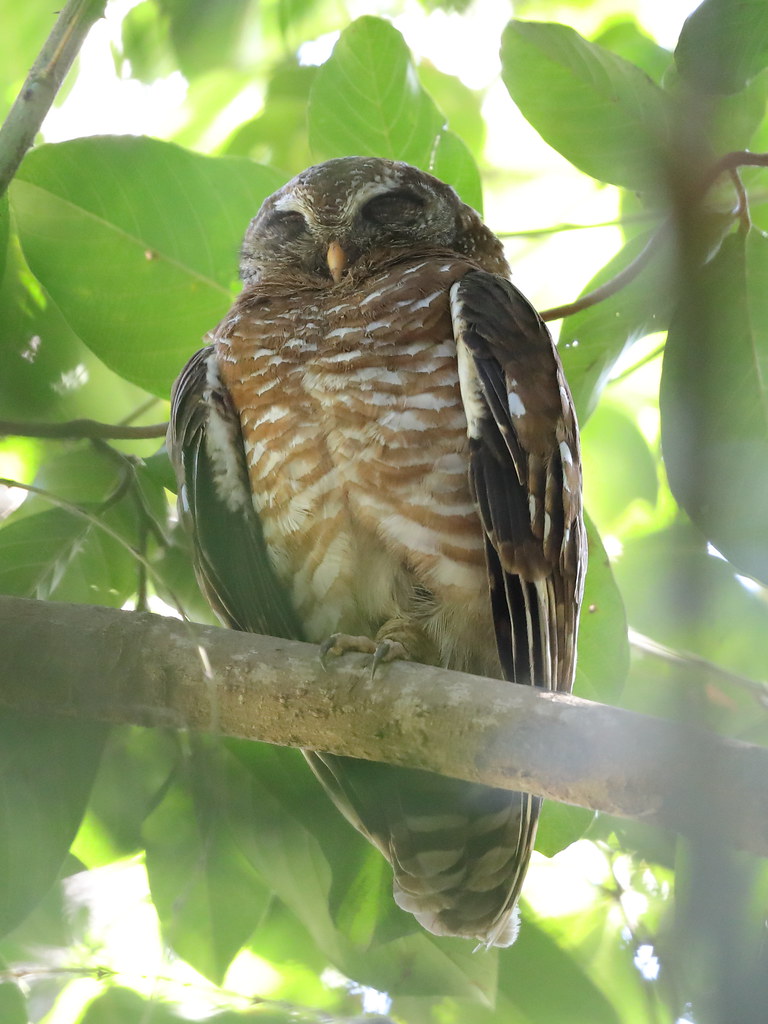 Another sleeping beauty!
Now from previous experience I know that we were very close to a well known site for White-backed Night Heron where I have been taken to on a separate tour by the same guide despite him taking me to see the said Owl. That's how some of them work. They have special birds that they think will make the sale of the trip.
On this trip it wasn't the Owls I was sold on, it was the promise of Yellow-throated Longclaw which was to be our last port of call. First though we were taken back to where we had picked up the forest guide where there are a few seats, some watering holes( bowls of water) and the opportunity to eat our packed breakfasts as provided by the hotel. Again, from a purely photographic point of view not ideal because of distance to the subject, poor light and rather artificial set up.
Again though, they delivered.
Another sleeping beauty!
Now from previous experience I know that we were very close to a well known site for White-backed Night Heron where I have been taken to on a separate tour by the same guide despite him taking me to see the said Owl. That's how some of them work. They have special birds that they think will make the sale of the trip.
On this trip it wasn't the Owls I was sold on, it was the promise of Yellow-throated Longclaw which was to be our last port of call. First though we were taken back to where we had picked up the forest guide where there are a few seats, some watering holes( bowls of water) and the opportunity to eat our packed breakfasts as provided by the hotel. Again, from a purely photographic point of view not ideal because of distance to the subject, poor light and rather artificial set up.
Again though, they delivered.
 Blue-spotted Wood-dove
Blue-spotted Wood-dove
 Black-necked Weaver pair as well as the only Orange-cheeked Waxbill of my holiday.
Black-necked Weaver pair as well as the only Orange-cheeked Waxbill of my holiday.
 The same applied to Klaas's Cuckoo which I managed to capture before it landed on the edge of a white plastic bowl.
The same applied to Klaas's Cuckoo which I managed to capture before it landed on the edge of a white plastic bowl.
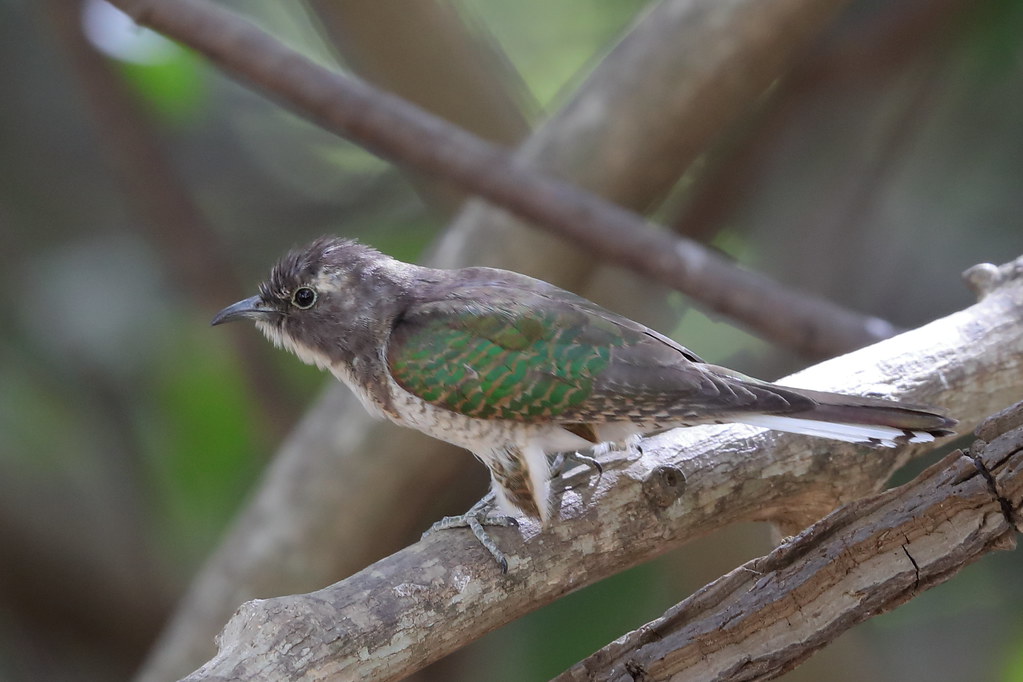 and indeed a Stone Partridge too.
and indeed a Stone Partridge too.
 What on earth is he complaining about you may well ask?! That's already 16 species not seen anywhere else and one more to come and in fairness I agree to a large extent but you also have to remember that I'm lucky enough that my equipment is as good as it gets really so I am better equipped than most to take advantage over poor light and distance.
Our final visit was to that Longclaw site, and after a brief walk around some cultivated fields we were told it wasn't there today. We did get a compensatory Grey Kestrel though.... albeit at distance.
What on earth is he complaining about you may well ask?! That's already 16 species not seen anywhere else and one more to come and in fairness I agree to a large extent but you also have to remember that I'm lucky enough that my equipment is as good as it gets really so I am better equipped than most to take advantage over poor light and distance.
Our final visit was to that Longclaw site, and after a brief walk around some cultivated fields we were told it wasn't there today. We did get a compensatory Grey Kestrel though.... albeit at distance.
 I later discovered the Longclaw hasn't apparently been seen all season!
TBC
I later discovered the Longclaw hasn't apparently been seen all season!
TBC








































































